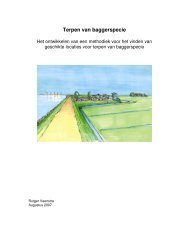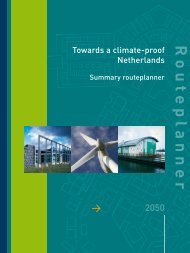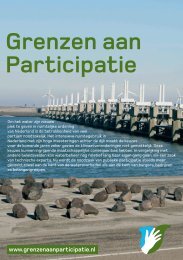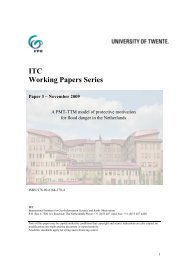KvR report 001/2006Nourishment <strong>of</strong> <strong>the</strong> Dutch beaches.Nowadays, foreshore nourishment iscomm<strong>on</strong> practice, whereup<strong>on</strong> currentstransport <strong>the</strong> sand, reinforcing <strong>the</strong> coastelsewhere: a fine example <strong>of</strong> how usecan be made <strong>of</strong> natural processes al<strong>on</strong>g<strong>the</strong> coast (Rijkswaterstaat).Removing sea walls and coastal defense worksIn places where <strong>the</strong> coastline used to be weak, or where <strong>the</strong>re are enclosed seainlets, <strong>the</strong> coast is heavily protected by rubble, sea walls or o<strong>the</strong>r coastal defenseworks. Strangely enough, breaking through <strong>the</strong>se coastal defenses could actually<strong>of</strong>fer a soluti<strong>on</strong> to <strong>the</strong> problem <strong>of</strong> <strong>the</strong> future rising <strong>of</strong> <strong>the</strong> sea level (Figure 4.2).Figure 4.2:The H<strong>on</strong>dsbossche sea wall al<strong>on</strong>g <strong>the</strong> Dutch coast. By breakingthrough <strong>the</strong> sea wall, part <strong>of</strong> <strong>the</strong> land behind it will flood <strong>with</strong> <strong>the</strong> tides.The silt caught up in <strong>the</strong> vegetati<strong>on</strong> ensures that <strong>the</strong> land graduallyincreases in height in line <strong>with</strong> or even above sea level (Drawing byJeroen Helmer).<str<strong>on</strong>g>Deltas</str<strong>on</strong>g> <strong>on</strong> <strong>the</strong> <strong>move</strong>Dune managementClosed dune lines protect coastal lowlands against flooding from <strong>the</strong> seaward side.Dune management comprises <strong>of</strong> a number <strong>of</strong> measures (dune restorati<strong>on</strong>, dunerelocati<strong>on</strong>, natural dune dynamics and over-wash) that ensure <strong>the</strong> functi<strong>on</strong>ality <strong>of</strong>dunes as flood defenses (CPSL, 2005). Allowing natural dynamics and over-washhave clear ecological benefits as <strong>the</strong>y add to <strong>the</strong> naturalness <strong>of</strong> <strong>the</strong> envir<strong>on</strong>ment.Natural dune dynamics encompass <strong>the</strong> wind driven transport <strong>of</strong> sand to <strong>the</strong> innerpart <strong>of</strong> <strong>the</strong> coast line where accumulati<strong>on</strong> causes a gradual shift and heightening.When allowing over-washes, water and sand is, during storm surges, transportedthrough wash-over channels, where accumulati<strong>on</strong> causes a gradual shift <strong>of</strong> <strong>the</strong> land<strong>with</strong> <strong>the</strong> rising sea level (CPSL I, 2001). Natural dune dynamics are <strong>on</strong>ly applicablewhen enough sand (from a natural origin or from sand nourishment) is available.Dune restorati<strong>on</strong> and relocati<strong>on</strong>, e.g., by building sand fences or planting grasses, dointerfere <strong>with</strong> nature. However, from an ecological point <strong>of</strong> view, <strong>the</strong>se techniquesare to be preferred above hard c<strong>on</strong>structi<strong>on</strong>s like dikes or groynes that wouldo<strong>the</strong>rwise become necessary. Especially <strong>with</strong> rising sea level, dune relocati<strong>on</strong> incombinati<strong>on</strong> <strong>with</strong> sand nourishment might be a sustainable strategy to maintaindefense standards.Vegetati<strong>on</strong> managementFor coastal defense salt marshes, mangroves and o<strong>the</strong>r coastal vegetati<strong>on</strong>s are in<strong>the</strong> first place important because <strong>the</strong> energy-impact <strong>of</strong> storm waves is reduced. Infr<strong>on</strong>t <strong>of</strong> dikes <strong>the</strong>y also prevent damage at <strong>the</strong> outer dike foot. Fur<strong>the</strong>rmore, coastalvegetati<strong>on</strong>s create a low-energy envir<strong>on</strong>ment where <strong>the</strong> sedimentati<strong>on</strong> <strong>of</strong> suspendedmaterial is enhanced, and erosi<strong>on</strong> <strong>of</strong> accumulated sediment is hindered (CPSL,2005). Management <strong>of</strong> coastal vegetati<strong>on</strong> comprises <strong>of</strong> techniques to enhance andmaintain <strong>the</strong> vegetati<strong>on</strong>.In <strong>the</strong> Dutch Wadden sea most salt marshes developed in combinati<strong>on</strong> <strong>with</strong> <strong>the</strong>c<strong>on</strong>structi<strong>on</strong> <strong>of</strong> groynes, which reduce wave energy and currents, and create anenvir<strong>on</strong>ment where sedimentati<strong>on</strong> prevails and erosi<strong>on</strong> is lessened. In groyne fieldssedimentati<strong>on</strong> rates up to 30 cm/yr occur in <strong>the</strong> first year after c<strong>on</strong>structi<strong>on</strong>(Erchinger et al., 1996), creating an envir<strong>on</strong>ment where vegetati<strong>on</strong> can germinate.C<strong>on</strong>structi<strong>on</strong> <strong>of</strong> groynes interferes <strong>with</strong> natural dynamics and should <strong>on</strong>ly be inducedin areas where <strong>the</strong> recovery <strong>of</strong> vegetati<strong>on</strong> in a natural way is not possible. Incombinati<strong>on</strong> <strong>with</strong> vegetati<strong>on</strong> large beds <strong>of</strong> mussels, oysters or sea grass also aims atstimulating accumulati<strong>on</strong> <strong>on</strong>, and stabilizati<strong>on</strong> <strong>of</strong> inter tidal flats.Separati<strong>on</strong> <strong>of</strong> shipping routes and waterways to port townsTraditi<strong>on</strong>ally, many ports in river mouths are situated in delta areas. Majormodificati<strong>on</strong>s have <strong>of</strong>ten had to be made in ports in order to be able to accommodateincreasingly large ships. For example, frequent large-scale dredging is needed inorder to maintain <strong>the</strong> depth <strong>of</strong> <strong>the</strong> harbors, which act as settling basins for a lot <strong>of</strong>sediment. The natural flows <strong>of</strong> sediment and water in <strong>the</strong> delta are disrupted by this.The sediment no l<strong>on</strong>ger benefits <strong>the</strong> maintenance <strong>of</strong> <strong>the</strong> delta fr<strong>on</strong>t, resulting in <strong>the</strong>erosi<strong>on</strong> and receding <strong>of</strong> <strong>the</strong> delta. Research needs to be carried out into whe<strong>the</strong>r it ispossible to separate <strong>the</strong> routes used by <strong>the</strong> deep ships from <strong>the</strong> waterways used by<strong>the</strong> water and <strong>the</strong> sediment.3435
KvR report 001/2006On <strong>the</strong> delta plainDevelopment or planting <strong>of</strong> mangroves and lowland riparian forestsVegetati<strong>on</strong> and woodlands in delta areas play an important role, as <strong>the</strong>y trap <strong>the</strong>sediment during flooding, thus allowing <strong>the</strong> land to rise (see photo). They also hinder<strong>the</strong> process <strong>of</strong> erosi<strong>on</strong> and form a natural barrier for waves and floating ice that canpose a threat to dikes and residential areas in <strong>the</strong> delta area. Mangrove areas andlowland riparian forests can be combined well <strong>with</strong> storage areas. Due to <strong>the</strong> highproducti<strong>on</strong> level, woods can also satisfy a porti<strong>on</strong> <strong>of</strong> <strong>the</strong> energy needs <strong>of</strong> <strong>the</strong>inhabitants <strong>of</strong> a delta area.Left: Landsat TM Image <strong>of</strong> <strong>the</strong> Bengalisland <strong>of</strong> Hatia (Ganges-Brahmaputradelta). A dense z<strong>on</strong>e <strong>of</strong> vegetati<strong>on</strong> (redcolor) prevents <strong>the</strong> coast from erodingby wave currents (Boskalis).Down: Mangrove forests trap sedimentduring flooding, thus allowing <strong>the</strong> landto rise (www.toddadams.net)<str<strong>on</strong>g>Deltas</str<strong>on</strong>g> <strong>on</strong> <strong>the</strong> <strong>move</strong>Saeftinghe. “Depoldered” areaswhere <strong>the</strong> tide is <strong>on</strong>ce againallowed to enter – sometimesafter several centuries – have<strong>the</strong> potential to grow into uniquewildlife areas(www.hetzeeuwselandschap.nl).Wetlands as retenti<strong>on</strong> areasDue to <strong>the</strong> reclamati<strong>on</strong> <strong>of</strong> land (impoldering) and <strong>the</strong> c<strong>on</strong>structi<strong>on</strong> <strong>of</strong> dikes, <strong>the</strong>flooding that is generally characteristic <strong>of</strong> delta plains is largely a thing <strong>of</strong> <strong>the</strong> past in<strong>the</strong> Dutch delta. By removing <strong>the</strong> dikes in sparsely populated regi<strong>on</strong>s and allowingc<strong>on</strong>trolled flooding in certain areas, sufficient storage space will <strong>on</strong>ce again becreated, thus preventing <strong>the</strong> breaking <strong>of</strong> dikes in more densely populated locati<strong>on</strong>s in<strong>the</strong> event <strong>of</strong> extremely high water (Figure 4.3). By building c<strong>on</strong>trolled inundati<strong>on</strong>areas al<strong>on</strong>g <strong>the</strong> river Scheldt <strong>the</strong> same degree <strong>of</strong> safety is achieved as in <strong>the</strong>Ne<strong>the</strong>rlands, where people have chosen to close most <strong>of</strong> <strong>the</strong> branches <strong>of</strong> <strong>the</strong> Rhine.But <strong>the</strong> Belgian soluti<strong>on</strong> proves to be more flexible than <strong>the</strong> Dutch approach. Instead<strong>of</strong> large scale erosi<strong>on</strong> and loss <strong>of</strong> tidal flats, <strong>the</strong> morfodynamic forces in this branch<strong>of</strong> <strong>the</strong> delta are still intact allowing <strong>the</strong> land to rise <strong>with</strong> <strong>the</strong> sea level throughsedimentati<strong>on</strong> (Saeijs et al., 2004).Figure 4.3:In <strong>the</strong> regi<strong>on</strong> around <strong>the</strong> Biesbosch, a former freshwater tidal marsh in<strong>the</strong> Ne<strong>the</strong>rlands, <strong>the</strong>re is sufficient space to create such a storage area,thus enabling drainage peaks in <strong>the</strong> Rhine and <strong>the</strong> Meuse to be leveled<strong>of</strong>f (Drawing by Jeroen Helmer).Managed retreat (<strong>on</strong>tpolderen)In tide-dominated <strong>deltas</strong>, <strong>the</strong> dimensi<strong>on</strong>s <strong>of</strong> <strong>the</strong> distributaries through which <strong>the</strong> waterflows in and out are determined by <strong>the</strong> size <strong>of</strong> <strong>the</strong> area behind <strong>the</strong>m that is allowed t<strong>of</strong>lood (<strong>the</strong> tide storage). If that flood area is reclaimed, <strong>the</strong> size <strong>of</strong> <strong>the</strong> tide storagedeclines and <strong>the</strong> natural resp<strong>on</strong>se <strong>of</strong> <strong>the</strong> system is for <strong>the</strong> river mouth to silt up.Numerous towns and cities in <strong>the</strong> Rhine delta area have lost <strong>the</strong>ir open c<strong>on</strong>necti<strong>on</strong><strong>with</strong> <strong>the</strong> sea in this way in <strong>the</strong> past. The resp<strong>on</strong>se <strong>of</strong> <strong>the</strong> inhabitants <strong>of</strong> those townsand cities is to try to maintain <strong>the</strong> depth <strong>of</strong> <strong>the</strong> river mouth by means <strong>of</strong> dredging. Thedecisi<strong>on</strong> was recently taken to “depolder” 600 hectares <strong>of</strong> diked-in land al<strong>on</strong>g <strong>the</strong>Western Scheldt at <strong>the</strong> same time as dredging work was being carried out in order tomaintain <strong>the</strong> equilibrium in <strong>the</strong> river mouth (see photo). A fur<strong>the</strong>r c<strong>on</strong>sequence <strong>of</strong> thisis that sediment-rich water can reach <strong>the</strong>se areas <strong>on</strong>ce again, allowing <strong>the</strong> land torise in step <strong>with</strong> <strong>the</strong> sea level.3637
















